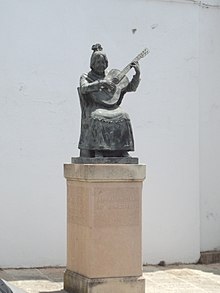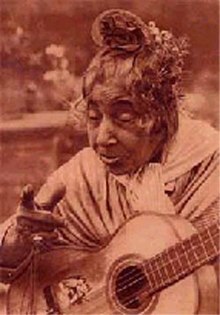
Flamenco is an art form based on the various folkloric music traditions of southern Spain, developed within the gitano subculture of the region of Andalusia, and also having historical presence in Extremadura and Murcia. In a wider sense, the term is used to refer to a variety of both contemporary and traditional musical styles typical of southern Spain. Flamenco is closely associated to the gitanos of the Romani ethnicity who have contributed significantly to its origination and professionalization. However, its style is uniquely Andalusian and flamenco artists have historically included Spaniards of both gitano and non-gitano heritage.
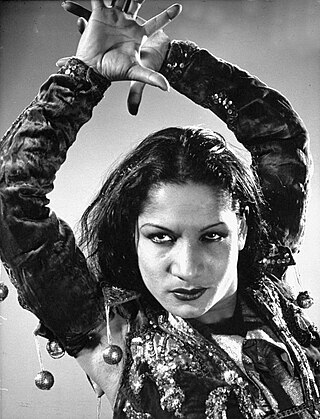
Carmen Amaya was a Spanish Romani flamenco dancer and singer, born in the Somorrostro district of Barcelona, Catalonia, Spain.

Siguiriyas are a form of flamenco music in the cante jondo category. This deep, expressive style is among the most important in flamenco. Unlike other palos of flamenco, siguiriyas stands out for being purely Romani (Calé) in origin. Siguiriyas are normally played in the key of A Phrygian with each measure consisting of 12 counts with emphasis on the 1st, 3rd, 5th, 8th and 11th beats as shown here:

Sabicas was a Spanish flamenco guitarist of Romani origin.
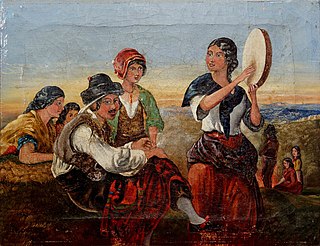
The Romani in Spain, generally known by the endonym Calé, or the exonym gitanos, belong to the Iberian Romani subgroup known as Calé, with smaller populations in Portugal and in Southern France. Their sense of identity and cohesion stems from their shared value system, expressed among gitanos as las leyes gitanas.

Manuel Ortega Juárez was a Spanish flamenco cantaor (singer).
Polo is the name of a flamenco palo or musical form. There is only one known song in this palo, which is extremely similar to another palo called caña, and its guitar accompaniment, like the caña, shares its rhythm and motifs with soleá. Both the caña and polo share the same musical mode. The polo has usually been considered as a derivation of the caña. To complete the singing of the polo, singers usually sing a stanza in the palo of soleá, generally in the style called soleá apolá.

Silverio Franconetti y Aguilar, also known simply as Silverio was a singer and the leading figure of the period in flamenco history known as The Golden Age, which was marked by the creation and definition of most musical forms or palos, the increasing professionalization of flamenco artists, and the shift of center from private gatherings and taverns towards commercial venues called cafés cantante. Silverio's voice was called “the honey from Alcarria”.
Cantes de ida y vuelta is a Spanish expression literally meaning roundtrip songs. It refers to a group of flamenco musical forms or palos with diverse musical features, which "travelled back" from Latin America as styles that, having originated in the interplay between musical traditions of peninsular Spain and those of Latin America, developed into renewed forms that were reintroduced in Spain. Usually they have a more mellow character than the more traditional flamenco songs.

José Tejada Marín, known as Pepe Marchena and also as Niño de Marchena in the first years of his career, was a Spanish flamenco singer who achieved great success in the ópera flamenca period (1922–1956). Influenced by singers like Antonio Chacón, he carried to the extreme the tendency to a more mellow and ornamented style of flamenco singing. Owing to his particular vocal conditions and singing style, he excelled mainly in palos (styles) like fandangos, cantes de ida y vuelta and cantes libres, contributing to making them the most popular flamenco styles in the era of the ópera flamenca, and created a new cante de ida y vuelta, the colombiana, later recorded by many other artists like El Lebrijano or Enrique Morente. He was also the first flamenco singer to use an orchestra to accompany flamenco singing, though later he returned to the guitar.
Juana la Macarrona was a Spanish flamenco dancer (bailaora).
The cante flamenco, meaning "flamenco singing", is one of the three main components of flamenco, along with toque and baile (dance). Because the dancer is front and center in a flamenco performance, foreigners often assume the dance is the most important aspect of the art form — in fact, it is the cante which is the heart and soul of the genre. A cante singer is a cantaor or cantaora.

El Concurso del Cante Jondo was a fiesta of flamenco arts, music, song, and dance, held in Granada in 1922. Conceived and initiated by composer Manuel de Falla, it enjoyed early and strong support from the poet Federico García Lorca. The two-day evening event was held outdoors at the Alhambra. The show included the best of well-known flamenco artists, but the contest's prize money was reserved for amateur performers.

Jairo Barrull Fernández artistically known as Jairo Barrull is a Spanish Gypsy flamenco dancer. He is son of Gypsy flamenco dancer Ramon Barrull, and great great nephew of the flamenco guitarist Diego del Gastor.
Ana Morales Moreno, known as Ana Morales, is a Spanish flamenco dancer and choreographer, who has established her own dance company.

Antonia La Negra, artistic name of Antonia Rodríguez Moreno, was a Spanish Gitana cantaora and bailaora. Wife of the bailaor Juan Montoya, mother of the singer Lole Montoya, of the duet Lole y Manuel, and grandmother of the singer Alba Molina.
Rita Giménez García, most commonly known as Rita la Cantaora, was one of the most famous Spanish singers of flamenco in her time due to her performances in cafés cantantes, places where flamenco artists used to play music live.

La Macanita is the artistic name of Tomasa Guerrero Carrasco, a Spanish flamenco singer.
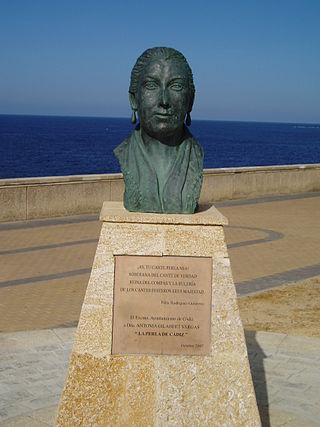
La Perla de Cádiz is the stage name of Antonia Gilabert Vargas, who was a Spanish gypsy (gitana) flamenco singer.

María Juncal is a Spanish flamenco dancer who has toured in Belgium, Canada, China, Cuba, France, Germany, Greece, Holland, Israel, Italy, Japan, Mexico, Spain, the U.S., and Venezuela. She has participated in different shows such as Jarocho under the direction of Richard O'Neal, assistant director of Riverdance, and has collaborated as a choreographer with Spain's women's national artistic gymnastics team, 2012. In addition to receiving the Excelencias Cuba Award 2018 2018 for her work in developing Cuban flamenco art, and winning the Antonio Gades National Award of Flamenco Dance, she was voted the best flamenco dancer at the Festival Del Cante De Las Minas.
